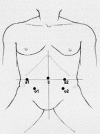Short- and medium-term outcome of robot-assisted and traditional laparoscopic rectal resection
- PMID: 19660212
- PMCID: PMC3015932
Short- and medium-term outcome of robot-assisted and traditional laparoscopic rectal resection
Abstract
Background: Traditional laparoscopic anterior rectal resection (TLAR) has recently been used for rectal cancer, offering good functional results compared with open anterior resection and resulting in a better postoperative early outcome. However, laparoscopic rectal resection can be technically demanding, especially when a total mesorectal excision is required. The aim of this study was to verify whether robot-assisted anterior rectal resection (RLAR) could overcome limitations of the laparoscopic approach.
Methods: Sixty-six patients with rectal cancer were enrolled in the study. Twenty-nine patients underwent RLAR and 37 TLAR. Groups were matched for age, BMI, sex ratio, ASA status, and TNM stage, and were followed up for a mean time of 12 months.
Results: Robot-assisted laparoscopic rectal resection results in shorter operative time when a total mesorectal excision is performed (165.9+/-10 vs 210+/-37 minutes; P<0.05). The conversion rate is significantly lower for RLAR (P<0.05). Postoperative morbidity was comparable between groups. Overall survival and disease-free survival were comparable between groups, even though a trend towards better disease-free survival in the RLAR group was observed.
Conclusion: RLAR is a safe and feasible procedure that facilitates laparoscopic total mesorectal excision. Randomized clinical trials and longer follow-ups are needed to evaluate a possible influence of RLAR on patient survival.
Figures


References
-
- Heald RJ, Husband EM, Ryall RD. The mesorectum in rectal cancer surgery—the clue to pelvic recurrence? Br J Surg. 1982;69(10):613–616 - PubMed
-
- Junginger T, Kneist W, Heintz A. Influence of identification and preservation of pelvic autonomic nerves in rectal cancer surgery on bladder dysfunction after total mesorectal excision. Dis Colon Rectum. 2003;46(5):621–628 - PubMed
-
- Leroy J, Jamali F, Forbes L, et al. Laparoscopic total mesorectal excision (TME) for rectal cancer surgery: long-term outcomes. Surg Endosc. 2004;18(2):281–289 - PubMed
-
- Gutt CN, Oniu T, Mehrabi A, et al. Robot-assisted abdominal surgery. Br J Surg. 2004;91(11):1390–1397 - PubMed
Publication types
MeSH terms
LinkOut - more resources
Full Text Sources
